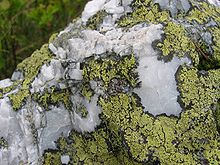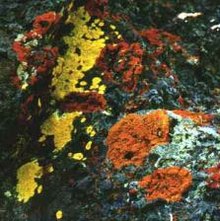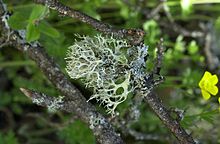Lichenology

Lichenology is the branch of
Study of lichens draws knowledge from several disciplines:
Methods for species identification include reference to
A chemical
Lichenologists may also study the growth and growth rate of lichens,
History
The beginnings
Lichens as a group have received less attention in classical treatises on botany than other groups although the relationship between humans and some species has been documented from early times. Several species have appeared in the works of
After the revolution in taxonomy brought in by Linnaeus and his new system of classification lichens are retained in the Plant Kingdom forming a single group Lichen with eight divisions within the group according to the morphology of the thallus.[6] The taxonomy of lichens was first intensively investigated by the Swedish botanist Erik Acharius (1757–1819), who is therefore sometimes named the "father of lichenology". Acharius was a student of Carl Linnaeus. Some of his more important works on the subject, which marked the beginning of lichenology as a discipline, are:
- Lichenographiae Suecia prodromus (1798)
- Methodus lichenum (1803)
- Lichenographia universalis (1810)
- Synopsis methodica lichenum (1814)


Later lichenologists include the American scientists
Over the years research shed new light into the nature of these organisms still classified as plants. A controversial issue surrounding lichens since the early 19th century is their reproduction. In these years a group of researchers faithful to the tenets of Linnaeus considered that lichens reproduced sexually and had sexual reproductive organs, as in other plants, independent of whether asexual reproduction also occurred. Other researchers only considered asexual reproduction by means of
19th century
Against this background appeared the Swedish botanist

But these works suffer from being superficial and mere lists of species without further physiological studies.[11] It took until the middle of the 19th century for research to catch up using biochemical and physiological methods. In Germany Hermann Itzigsohn[12] and Johann Bayrhoffer,[13] in France Edmond Tulasne and Camille Montagne, in Russia Fedor Buhse,[14] in England William Allport Leighton and in the United States Edward Tuckerman began to publish works of great scientific importance.
Scientific publications settled many unknown facts about lichens. In the French publication Annales des Sciences Naturelles in an article of 1852 "Memorie pour servir a l'Histoire des Lichens Organographique et Physiologique" by Edmond Tulasne, the reproductive organs or apothecia of lichens was identified.[15][16]
These new discoveries were becoming increasingly contradictory for scientists. The
It was

20th century
In 1909 the Russian lichenologist
Despite the above studies the dual nature of lichens remained no more than a theory until in 1939 the Swiss researcher Eugen A Thomas[21] was able to reproduce in the laboratory the phenotype of the lichen Cladonia pyxidata[22] by combining its two identified components.
During the 20th century botany and mycology were still attempting to solve the two main problems surrounding lichens. On the one hand the definition of lichens and the relationship between the two symbionts and the taxonomic position of these organisms within the plant and fungal kingdoms. There appeared numerous renowned researchers within the field of lichenology such as
Lichenology has found applications beyond
The difficulty of giving a definition applicable to every known lichen has been debated since lichenologists first recognised the dual nature of lichens. In 1982 the International Association for Lichenology convened a meeting to adopt a single definition of lichen drawing on the proposals of a committee. The chairman of this committee was the renowned researcher Vernon Ahmadjian. The definition finally adopted was that lichen could be considered as the association between a fungus and a photosynthetic symbiont resulting in a thallus of specific structure.[26]
Such a simple
Today studies in lichenology are not restricted to the description and taxonomy of lichens but have application in various scientific fields. Especially important are studies on

Lichens in pharmacology
Although several species of lichen have been used in
Interest in the potential of substances synthesised by lichens increased with the end of World War II along with the growing interest in all antibiotic substances. In 1947 antibacterial action was identified in extracts of Cetraria islandica and the compounds identified as responsible for bacterial inhibition were shown to be d-protolichosteric acid and d-1-usnic acid.[31] Further investigations have identified novel antibacterial substances, Alectosarmentin[32] or Atranorin.[33]
Antibacterial action of substances produced by lichens is related to their ability to disrupt bacterial
From the 1950s the lichen product
Recent work in the field of applied biochemistry has shown some antiviral activity with some lichen substances. In 1989 K Hirabayashi[36] presented his investigations on inhibitory lichen polysaccharides in HIV infection.[37]
Bibliography
- "Protocols in Lichenology: Culturing, Biochemistry, Ecophysiology and Use in Biomonitoring" (Springer Lab Manuals, Kraner, Ilse, Beckett, Richard and Varma, Ajit (28 Nov 2001)
- Lichenology in the British Isles, 1568–1975: An Historical and Biographical Survey, D. L. Hawksworth and M. R. D. Seaward (Dec 1977)
- "Lichenology: Progress and Problems" (Special Volumes/Systematics Association) Denis Hunter Brown et al. (10 May 1976)
- Lichenology in Indian Subcontinent, Dharani Dhar Awasthi (1 Jan 2000)
- Lichenology in Indian Subcontinent 1966–1977, Ajay Singh (1980)
- CRC Handbook of Lichenology, Volume II: v.2, Margalith Galun (30 Sep 1988)
- A Textbook of General Lichenology, Albert Schneider (24 May 2013)
- Horizons in Lichenology D. H. Dalby (1988)
- Bibliography of Irish Lichenology, M. E. Mitchell (Nov 1972)
- Diccionario de Liquenologia/Dictionary of Lichenology, Kenneth Allen Hornak (1998)
- "Progress and Problems in Lichenology in the Eighties: Proceedings" (Bibliotheca Lichenologica), Elisabeth Peveling (1987)
- A Textbook of General Lichenology with Descriptions and Figures of the Genera Occurring in the North Eastern United States, Albert Schneider (Mar 2010)
- The Present Status and Potentialities of the Lichenology in China, Liu Hua Jie (1 Jan 2000)
- Lichens to Biomonitor the Environment, Shukla, D. K. Vertika, Upreti and Bajpai, Rajesh (Aug 2013)
- Lichenology and Bryology in the Galapagos Islands with Checklists of the Lichens and Bryophytes thus far Reported, William A. Weber (1966)
- Flechten Follmann: Contributions to Lichenology in Honour of Gerhard Follmann, Gerhard Follmann, F. J. A. Daniels, Margot Schultz and Jorge Peine (1995)
- Environmental Lichenology: Biomonitoring Trace Element Air Pollution, Joyce E. Sloof (1993)
- The Journal of the Hattori Botanical Laboratory: Devoted to Bryology and Lichenology, Zennosuke Iwatsuki (1983)
- Contemporary Lichenology and Lichens of Western Oregon, W. Clayton Fraser (1968)
- Irish Lichenology 1858–1880: Selected Letters of Isaac Carroll, Theobald Jones, Charles Larbalestier (1996)
- Lichens from West of Hudson's Bay (Lichens of Arctic America Vol. 1), John W. Thompson (1953)
- Les Lichens - Morphologie, Biologie, Systematique, Fernand Moreau (1927)
- "Eric Acharius and his Influence on English Lichenology" (Botany Bulletins), David J. Galloway (Jul 1988)
- "Lichenographia Thompsoniana: North American Lichenology in Honour of John W. Thompson", M. G. Gleen (May 1998)
- "Monitoring with Lichens-Proceedings of the NATO Advanced Research Workshop", Nimis, Pier Luigi, Scheidegger, Christoph and Wolseley, Patricia (Dec 2001)
- Contributions to Lichenology: In Honour of A. Henssen, H. M. Jahns and A. Henssen (1990)
- Studies in Lichenology with Emphasis on Chemotaxonomy, Geography and Phytochemistry: Festschrift Christian Leuckert, Johannes Gunther Knoph, Kunigunda Schrufer and Harry J. M. Sipman (1995)
- Swedish Lichenology: Dedicated to Roland Moberg, Jan Erik Mattsson, Mats Wedin and Inga Hedberg (Sep 1999)
- Index of Collectors in Knowles the Lichens of Ireland (1929) and Porter's Supplement: with a Conspectus of Lichen, M. E. Mitchell, Matilda C. Knowles and Lilian Porter (1998)
- Biodeterioration of Stone Surfaces: Lichens and Biofilms as Weathering Agents of Rocks and Cultural Heritage, Larry St. Clair and Mark Seaward (Oct 2011)
- The Lichen Symbiosis, Vernon Ahmadjian (Aug 1993)
- Lichen Biology, Thomas H. Nash (Jan 2008)
- Fortschritte der Chemie organischer Naturstoffe/ Progress in the Chemistry of Organic Natural Products, S. Hunek (Oct 2013)
Notable lichenologists
- Henry Nicollon des Abbayes
- Erik Acharius
- Vernon Ahmadjian
- André Aptroot
- Johannes Müller Argoviensis
- Ferdinand Christian Gustav Arnold
- Heinrich Anton de Bary
- Friedrich August Georg Bitter
- Alphonse Boistel
- Antonina Borissova
- Jean-Baptiste Édouard Bornet
- Irwin M. Brodo
- François Fulgis Chevallier
- Louisa Collings
- Chicita F. Culberson
- William Louis Culberson
- Johann Jacob Dillenius
- Alexander Elenkin
- Andrei Famintsyn
- Elias Magnus Fries
- Nina Golubkova
- Carolyn Wilson Harris (1849–1910)
- David Leslie Hawksworth
- Georg Franz Hoffmann
- Peter Wilfred James
- August von Krempelhuber
- Georgij Karlovich Kreyer
- Syo Kurokawa
- William Allport Leighton
- Konstantin Mereschkowski
- Camille Montagne
- Sanjeeva Nayaka
- William Nylander
- Charles Christian Plitt
- Francis Rose
- Rolf Santesson
- Simon Schwendener
- Joseph Pitton de Tournefort
- Edward Tuckerman
- Edmond Tulasne
- Dalip Kumar Upreti
- Edvard August Vainio
- Erna Walter
- Heinrich Walter
- William Alfred Weber
- Francis Wilson
- Alexander Zahlbruckner
Lichen collections
- British Lichen Society[38]
- Botanische Staatssammlung München[39]
- Canadian Museum of Nature[40]
- Centraalbureau voor Schimmelcultures
- National Botanical Research Institute (CSIR), India[41]
- Iowa State University, Ada Hayden Herbarium, Ames, Iowa[42]
- National Museum Cardiff[43]
- Natural History Museum, London[44]
- New York Botanical Garden[45]
- Royal Botanic Garden, Edinburgh[46]
- Royal Botanic Gardens, Kew, London[47]
- University of Michigan Herbarium, Ann Arbor, Michigan[48]
- Ulster Museum, Belfast[51]
See also
- Outline of lichens
- Acharius Medal, an award in lichenology
Footnotes
- ^ "mostly Clavarieae", according to Druce.[4]
References
- ISBN 978-0300195736.
- ^ Lauder Lindsay, William (1856). A Popular History of British Lichens p. 22
- ^ Lauder Lindsay, William (1856). A Popular History of British Lichens p. 23
- ^ Eckel, P. M. (2010–2021). "A Grammatical Dictionary of Botanical Latin: coralloides". Missouri Botanical Garden. Retrieved 19 August 2021.
- ^ Joseph Pitton de Tournefort (1700). Institutiones rei herbariae [Institutions of botany] (in Latin). Vol. 1.
- ^ Lauder Lindsay, William (1856). A Popular History of British Lichens. p. 24.
- ^ Lauder Lindsay, William. A Popular History of British Lichens. p. 25.
- ^ Acharius, Erik (1814). Synopsis Methodica Lichenum: Systens omnes hujus ordinis naturalis detectas [Synopsis of lichen Methods, systems of this natural order detected] (in Latin). Svanborg.
- ^ "Edit History: Schaerer, Ludwig Emanuel (Louis-Emmanuel) (1785-1853) on JSTOR". plants.jstor.org.
- ^ Lauder Lindsay, William (1856). A Popular History of British Lichens. p. 27.
- JSTOR 2478161.
- ^ "Harvard University Herbaria & Libraries".
- ^ "Harvard University Herbaria & Libraries".
- ^ "Harvard University Herbaria & Libraries".
- S2CID 84605645.
- ^ Lauder Lindsay, William (1856). A Popular History of British Lichens. p. 23.
- ^ "Harvard University Herbaria & Libraries".
- JSTOR 3753090.
- S2CID 84580224.
- .
- ^ Species:Eugen A. Thomas
- ^ "Pixie Cups (Cladonia pyxidata)".
- ISBN 84-475-1923-6
- ^ "Archived copy" (PDF). Archived from the original (PDF) on 2014-02-03. Retrieved 2014-01-21.
{{cite web}}: CS1 maint: archived copy as title (link) - ISBN 978-0521812016.
- ^ a b David L. Hawksworth (1989) "Interactions Fungus and Alga in Lichen Symbiosis liquenoides" Annals of the Botanical Garden of Madrid (46).
- ^ http://lichens.science.oregonstate.edu/antibiotics/lichen_antibiotics.htm Mike Crockett, Stacie Kageyama, Delfina Homen, Carrie Lewis, Jane Osborn, Logan Sander (2003). "Antibacterial Properties of four Pacific North West Lichens".
- ^ "Wikispaces".
- PMID 17750561.
- ^ Bustinza, Francisco (1948) "Contribution to the Study of Antibiotics Produced by Lichens". Annals of the Botanical Garden of Madrid (7) ISSN pp. 511–548.
- ^ Bustinza, Francisco (1951) "Contribution to the Study of Antibacterial Activity in Cetraria islandica". Annals of the Botanical Garden of Madrid (10) ISSN pp. 144–149.
- PMID 7964789.
- .
- ^ Neli Kika Honda & Wagner Vilegas (1998) "The Chemistry of Lichens" (Port)[1] Química Nova 22(1) ISSN 0100-4042
- ^ "EBI Search".
- PMID 2575016.
- ^ Francisco Javier Toledo Marante, Ana Garcia Costellano, Francisco Leon Oyola and Jaime Bermejo Barrera "Ecologia Quimica en Hongos y Liquenes" (Spa) Columbian Academy of Science 28 ISSN 0370-3908 pp. 509–528 [2]
- ^ "Herbaria | The British Lichen Society". www.britishlichensociety.org.uk.
- ^ "The Lichen Collection at the Botanische Staatssammlung München". www.botanischestaatssammlung.de.
- ^ "Collections | Canadian Museum of Nature". nature.ca.
- ^ ":: Welcome to NBRI ::". www.nbri.res.in. Archived from the original on 2015-01-14.
- ^ "Herbarium: Iowa State University". Archived from the original on 2013-10-04. Retrieved 2014-01-24.
- ^ "Fungi & Lichens | National Museum Wales". Archived from the original on 2014-01-24. Retrieved 2014-01-24.
- ^ "Botany collections | Natural History Museum". www.nhm.ac.uk.
- ^ "Lichens - The William & Lynda Steere Herbarium". sweetgum.nybg.org.
- ^ "RBGE Lichen Taxonomy". February 1, 2014. Archived from the original on 2014-02-01.
- ^ "Royal Botanic Gardens, Kew: Science and Horticulture: Sending specimens to Kew". April 6, 2013. Archived from the original on 2013-04-06.
- ^ "University of Michigan Herbarium - Collections". February 2, 2014. Archived from the original on 2014-02-02.
- ^ "- Collections". December 19, 2023. Archived from the original on 2023-09-21.
- ^ "- Collections". December 19, 2023. Archived from the original on 2017-07-06.
- ^ "National Museums NI". www.nmni.com.
External links
- American Bryological and Lichenological Society
- Belgium, Luxembourg and Northern France, Lichens of
- British Lichen Society
- Central European Bryological and Lichenological Society (Ger)
- Checklists of Lichens and Lichenolous Fungi
- Chilean Lichens (Spa)
- Czech Bryological and Lichenological Society (Cze)
- French Lichenological Society (Fre)
- Guide to using a Lichen-Based Index to Assess Nitrogen Air Quality
- Identifying North American Lichens a Guide to the Literature
- International Association for Lichenology
- Irish Lichens Archived 2014-12-20 at the Wayback Machine
- Italian Lichenological Society (Ita)
- Japanese Lichenological Society (Eng)
- Japanese Lichenological Society (Eng)
- Lichenological Resources (Rus)
- Lichen Herbarium University of Oslo
- Lichenland Oregon State University
- Links to Lichens and Lichenologists
- Lichens of Ireland Project Archived 2014-12-20 at the Wayback Machine
- LichenPortal.org - The Consortium of Lichen Herbaria
- Microscopy of Lichens (Ger)
- Netherlands Bryological and Lichenological Society (nl)
- National Biodiversity Gateway
- Nordic Lichen Society (Eng)
- North American Lichens
- Paleo-Lichenology (Ger)
- Russian Lichens (Rus)
- Scottish Lichens
- Swedish Lichens Lief & Anita Stridvall
- Swiss Bryological and Lichenological Society (Ger)
- Tropical Lichens
- UK Lichens
